Meccano Model Exhibition 1982
Report written by Chris Warrell for our November 1982 Newsletter
Saturday 2 October 1982
Eltham United Reformed Church
Eltham
Despite the same torrential rain that we had last year, this year’s exhibition still brought the public in although not as many as before. However we certainly excelled ourselves when it came to models; it must rate as one of our best in quality, quantity and variety of exhibits.
Grateful thanks must of course go to all the visiting clubs and individual members who supported us and helped fill the tables to saturation point!
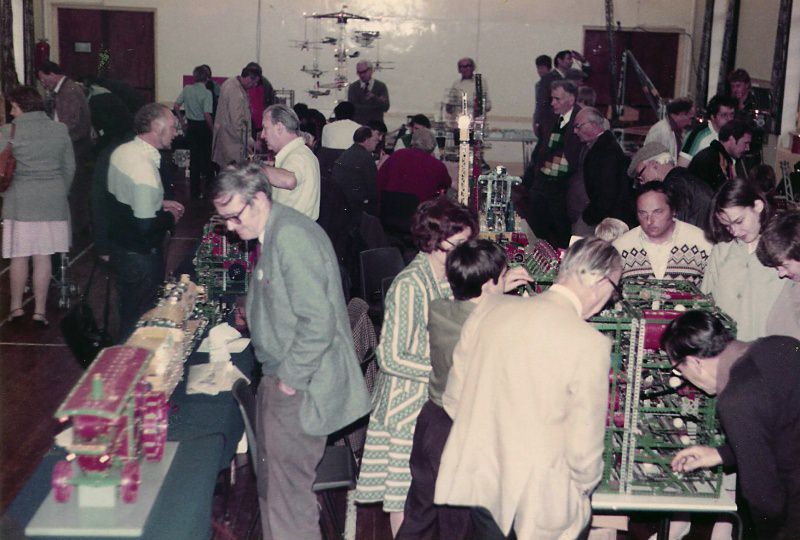
David Whitmore’s traction engine (left), Bert Love’s aeroplanes (centre) and Joyce and Eric Schoolar’s ping pong ball machine (right)
Models on Display
One of our largest models was a small derrick crane by David Smithers. That might sound rather strange but it was built to a scale such that the jib was about seven feet long. Like the prototype it could be easily taken apart into a number of long but manageable pieces. Unfortunately, due to a family crisis, David was not able to stay at the exhibition but very kindly transported his model over in the morning and retrieved it later. Consequently the crane had to remain motionless throughout the day! He also brought a remake of the Set № 8 beam engine in red and green with a mains motor for continuous running, a small factory engine and a small steam crane.
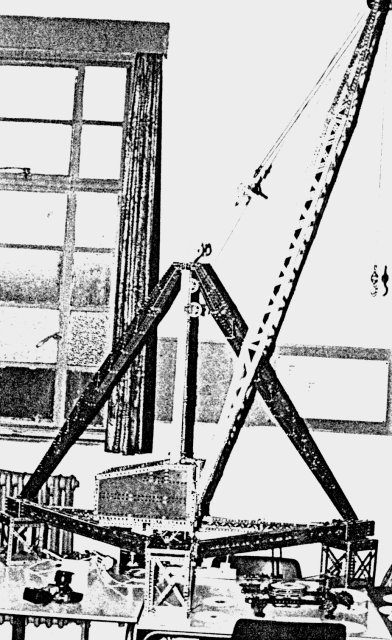
Derrick crane by David Smithers
Bert Love’s stand took up the rear wall of the hall allowing him to display a wider range of spares than before. Set in the centre of the stalls was his large display model tower in mint blue/gold Meccano with a rotating canopy from which no less than ten pre-war Meccano aeroplanes — all restored to exhibition standard — were suspended at different ‘altitudes’, standing six feet tall and illuminated by 18 Meccano 12V lamps, the model made a focal point for the visitors with its colourful display of aeroplanes, some of which are collectors’ items. The model was driven by a mains Crouzet motor.
A modified version of the Super Model № 24 travelling gantry crane was brought by Frank Palin. The alterations were to the arrangement of pulleys for trolley and hoist ropes. It employed a 6V pre-war motor and open ended type braced girders as originally specified. Also displayed was a flat bed lorry from Nick’s Transport Fleet, a sports car from the March 1962 issue of Meccano Magazine, Action Pack Grand Prix Car and selection of smaller Action Pack models.
A number of models were shown by Stan Bedford. One was a Dutch windmill from the old № 9 set instructions but with a few refinements. The base housed an automatic reversing mechanism which raised and lowered a loaded sack. A model of Keith Cameron’s small fairground octopus and Andreas Konkoly’s clockwork-driven centrifugal intermittent motion were also brought. A most unusual model, but only partly completed, was a Ballybunion monorail locomotive, the prototype of which ran on a sort of trestle track in Ireland.
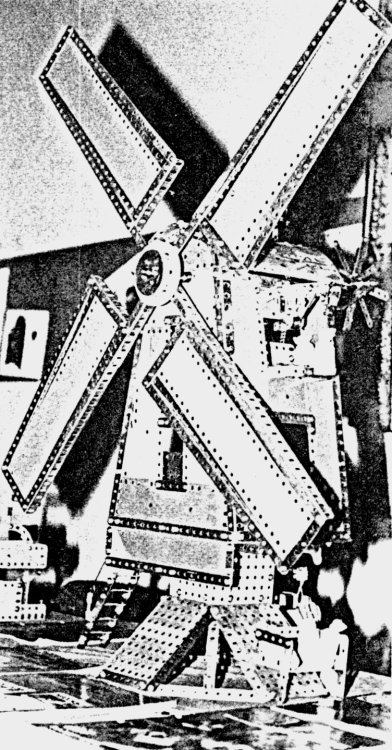
Windmill built by Stan Bedford
A robot arm, the winning model in our recent Junior Model Building Competition, was there with its owner Martin Clark. The model consisted of a short square tower surmounted by a turntable. A box structure open at opposite ends formed the top of the turntable and this housed a long square arm which was free to travel about 8” horizontally back and forth. At the end of the arm were two vertical built up angles 31” long with a frame free to slide up and down. The grab was fixed to this such that it could rotate vertically through 360°. Five motors were used in all, each one powering a different movement. The model was remote-controlled with the exception of the one E15R motor which had to be reversed manually; this powered the sliding frame. The turntable and travelling-arm-wore powered by PDUs. The former consisted of a 7½” circular strip with eight 1” pulleys and tyres arranged around it which bore onto the flat surfaces above and beneath. A crane set motor operated the grab rotation and another one worked the jaws. The wires for this passed through the slot in a rod with keyway. A clutch allowed a constant pressure to be applied to any object being picked up.
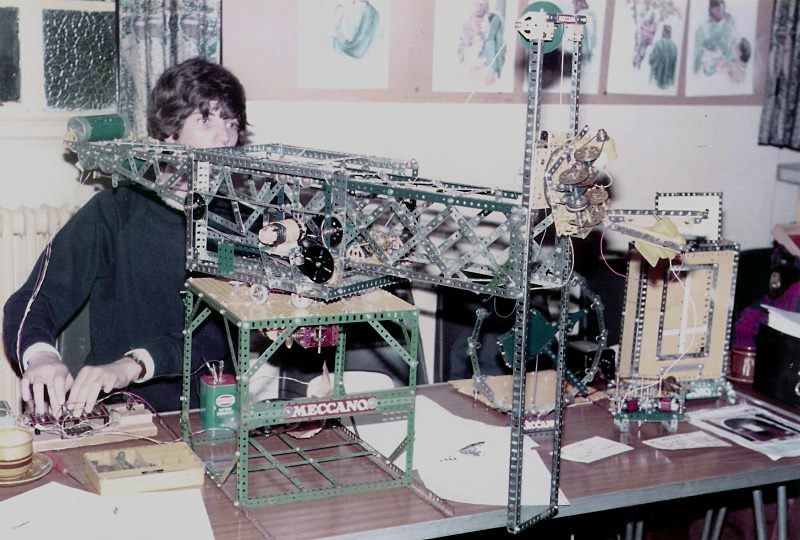
Martin Clark’s robotic arm
Bryn Jones brought two models; one built in Meccano, the other in Märklin. The former was a Pettit Through Truss Bridge, carrying a deck of 4½” x 2½” plates, in which the trusses were connected by bracing in the form of rods. Portal frames at each end consisted of double braced girders and the bridge was supported on twin tapered piers. The other model, built in Märklin, was a freelance commercial vehicle chassis still under construction. The wheels consisted of 3¾” flanged discs with rubber tyres made from Electrolux fan belts. A simple two-speed and reverse constant mesh gearbox made use of 19-tooth and 25-tooth pinions with dog clutch. Leaf springs were used on the rear axle and coil springs on the front. The latter was formed of two Märklin multikit heavy-duty springs, one on top of the other, over a rod and spaced with collars. Steering was by means of a worm and pinion arrangement at the top of each ‘king pin’. The worms were driven by rod and universal joint linkages allowing for substantial play in the suspension.
A large assortment of small models was displayed by Geoff Davison; A tower crane with a 2” square tower and roller bearing; A Kenworth Conventional Tractor with box trailer using wheels from the Dinky Toys Michigan Road Grader; Dump truck powered by French electric motor; Artillery tractor and gun from Army Multikit parts; Breakdown truck and low loader using Multikit parts; Clockwork farm tractor; Space ship using space outfit parts; Small scale tank transporter with Dinky Toys tank; Two trucker fleet models.
Other models from our club were:
Robin Lake — A simple crawler crane with track reversing gear, in which the operating levers were moved in the direction of the function; i.e. , forward and the load was lowered, backwards and the load was raised; A gadget for measuring the mechanical efficiency of Meccano gearing or chain drives; A two-wheeled clockwork cart which reversed on impact; A mystery gear train in which the output rotated in the same direction no matter what way the input was turned; Four intercyclic variable ratio drives.
Les Maher — Racing tricycle using 6” pulleys for wheels; Meccano hand drill-with twist bit fixed in coupling.
Bill Lovell — Forklift truck driven by Marx hectoperm through two speed gearbox. Its rear wheels were steered by means of PDU and forks raised by similar motor.
Adrian Ashford — Fire engine and pannier tank locomotive.
Noel Ta’Bois — Chronalog Mk 2 — similar to Mk 1 but with a 4½” x 7½” high face instead of 4½” square; Meccano mystery clock; № 2 chiming clock from Meccano Clock Kit.
Fred Pragnell — Block setting crane and dredger.
John Westwood — Gladstone Pottery machinery.
Peter Clay — Two Konkoly Meccanographs.
Joyce and Eric Schoolar — Original ping pong ball machine; Designograph, Half track; Clockwork swing boat.
John Adams – № 10 set block-setting crane but with redesigned gearbox incorporating three PDUs to give complete remote control.
Chris Warrell — Modified Super Model breakdown crane and Perrier mineral water model (Meccaneau).
Neil Bedford — Scorpion Tank; Tractor chassis; Simple ping pong ball machine.
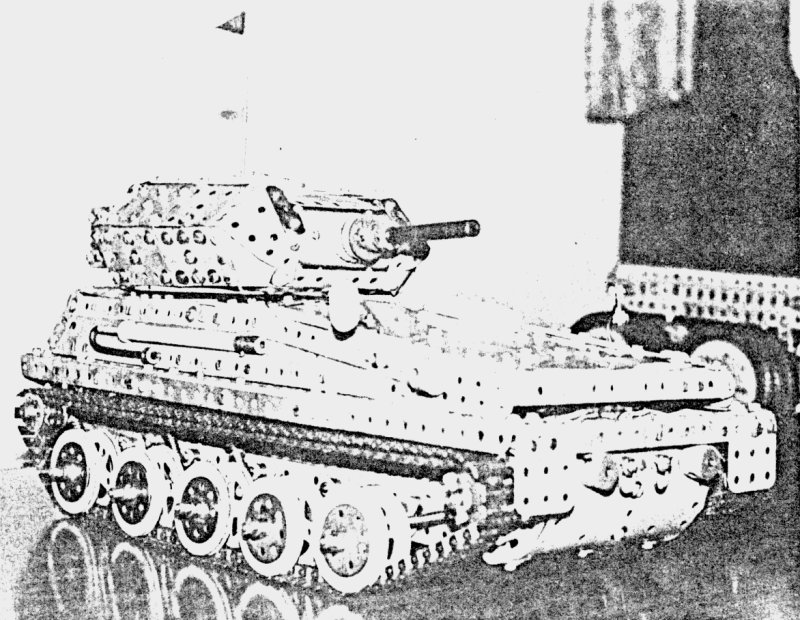
Neil Bedford’s Scorpion tank
John Longbon – Level-luffing dock crane.
David Whitmore — Aeroplane engine; Locomotive; Traction engine.
Paul Bedford — Cargo ship.
Jim Arthur — Clockwork walking man and cart.
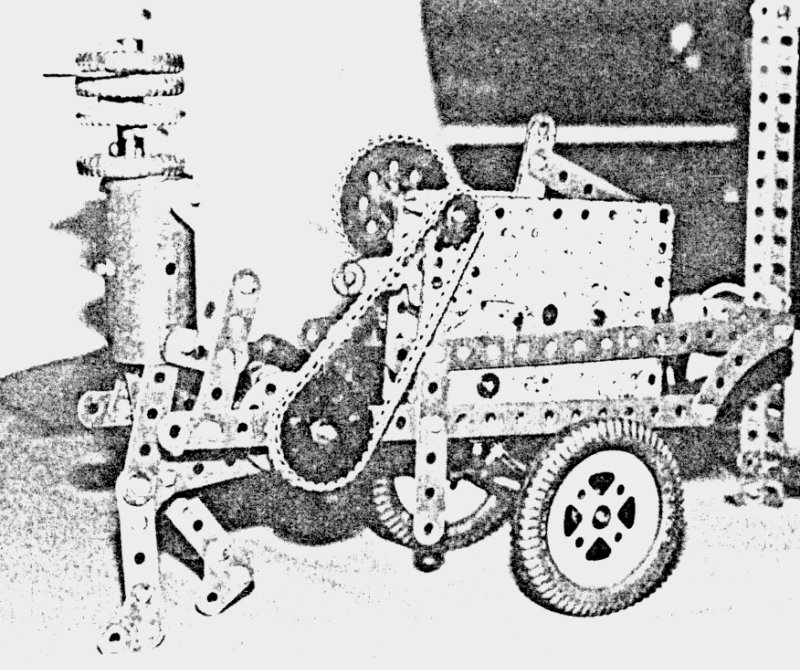
Walking man by Jim Arthur
Mick Burgess (from Kettering) — Selling second-hand Meccano, replicas and Aeroplane Set parts.
West London Meccano Society
Nick Rodgers — Cutty Sark ship; Rail snowplough; Transport Fleet models.
Ron Stutter — German tower crane.
Melvyn Down — Beam engine.
David Nye — Designing machine.
Geoff Pollock — Selling new and second-hand Meccano, Märklin etc.
One apology for absence was received from Eddie Oatley who, due to a family bereavement late on Friday evening, was not able to attend. Thanks to everyone who attended (including those I have forgotten to mention). Ta also to the ladies who kept exhibitors and public alike well topped up with tea and rolls. They were Mrs. Ashford, Mrs. Bedford, Mrs. Palin and Mrs. Warrell (my mother). Thanks to my wife, Cathy, and various members who did their stint on the door collecting money.
A report on the exhibition in the Eltham Times appeared the week after the exhibition.
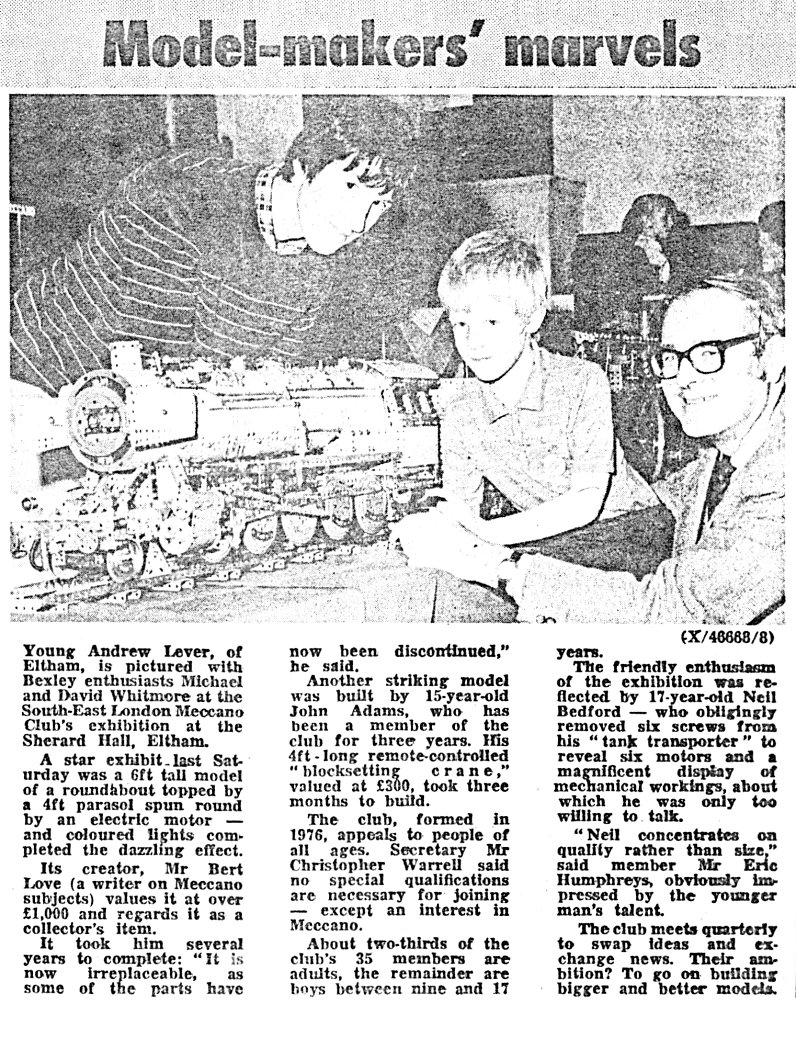
Cutting from the Eltham Times, 7th October 1982